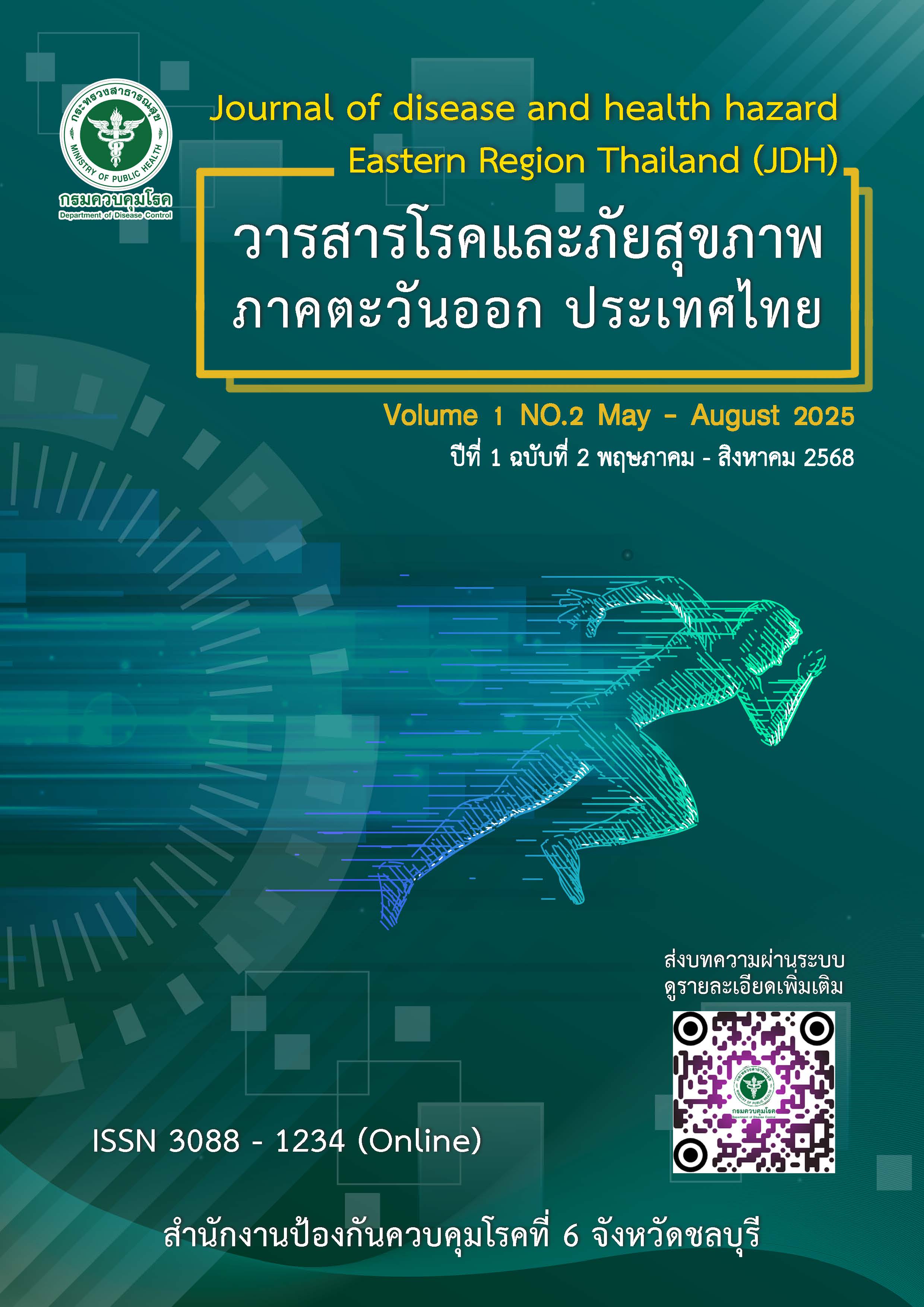ปัจจัยสนับสนุนที่มีผลต่อความรอบรู้ด้านสุขภาพในการป้องกัน โรคไม่ติดต่อเรื้อรังของอาสาสมัครสาธารณสุขประจำหมู่บ้าน อำเภอบางบ่อ จังหวัดสมุทรปราการ
Main Article Content
บทคัดย่อ
ความรอบรู้ด้านสุขภาพมีบทบาทสำคัญในการลดปัญหาโรคไม่ติดต่อเรื้อรัง (NCDs) โดยเฉพาะอย่างยิ่งในกลุ่มอาสาสมัครสาธารณสุขประจำหมู่บ้าน (อสม.) ซึ่งเป็นกลไกสำคัญในการสื่อสารและเผยแพร่ความรู้ด้านสุขภาพสู่ประชาชนในระดับชุมชน การศึกษานี้มีวัตถุประสงค์เพื่อศึกษาปัจจัยส่วนบุคคล ปัจจัยสนับสนุนความรอบรู้ด้านสุขภาพในการป้องกัน NCDs ศึกษาระดับความรอบรู้ในการป้องกัน NCDs และศึกษาปัจจัยสนับสนุนที่มีผลต่อความรอบรู้ด้านสุขภาพในการป้องกัน NCDs ของ อสม.ในอำเภอบางบ่อ จังหวัดสมุทรปราการ เป็นการศึกษาเชิงพรรณนาแบบภาคตัดขวาง กลุ่มตัวอย่าง คือ อสม.จำนวน 265 คน สุ่มกลุ่มตัวอย่างแบบชั้นภูมิ เก็บรวบรวมข้อมูลด้วยแบบสอบถามที่ผ่านการตรวจสอบคุณภาพด้านความตรงเชิงเนื้อหาและมีความเชื่อมั่นระหว่าง 0.95 - 0.99 การวิเคราะห์ข้อมูลใช้สถิติเชิงพรรณนา และสถิติเชิงอนุมาณด้วย Pearson’s Correlation และ Enter Multiple Regression Analysis ผลการศึกษา พบว่า ปัจจัยส่วนบุคคลของ อสม. ส่วนใหญ่มากกว่าร้อยละ 60 อายุมากกว่า 50 ปี เป็นเพศหญิง ระดับการศึกษาน้อยกว่าระดับอนุปริญญา มีประสบการณ์ในการเป็น อสม. มากกว่า 7 ปีขึ้นไป เคยเข้าร่วมอบรมด้านสุขภาพมากกว่า 5 ครั้ง และมีปัจจัยสนับสนุนความรอบรู้ด้านสุขภาพในการป้องกัน NCDs อยู่ในระดับมากถึงมากที่สุด ดังนี้ คือ การสนับสนุนจากทัศนคติและ แรงจูงใจ (Mean = 4.53, S.D.=0.58) การเข้าถึงข้อมูลสุขภาพ (Mean = 4.31, S.D.= 0.64) การสนับสนุนจากหน่วยงานสาธารณสุข (Mean = 4.42, S.D.= 0.64) การสนับสนุนจากเครือข่ายชุมชน (Mean = 4.18, S.D.=0.79) และพบว่าระดับความรอบรู้ด้านสุขภาพในการป้องกัน NCDs อยู่ในระดับมาก (Mean = 4.32, S.D.= 0.62) และปัจจัยสนับสนุนที่มีผลต่อความรอบรู้ด้านสุขภาพในการป้องกัน NCDs อย่างมีนัยสำคัญทางสถิติที่ 0.05 เรียงตามการมีอิทธิพลในการทำนาย ดังนี้ คือ การเข้าถึงข้อมูลสุขภาพ (Beta=0.56, p-value < 0.001) การสนับสนุนจากเครือข่ายชุมชน (Beta=0.27, p-value < 0.001) และการสนับสนุนด้านทัศนคติและแรงจูงใจ (Beta=0.13, p-value < 0.001) สามารถร่วมกันทำนายความรอบรู้ด้านสุขภาพในการป้องกันโรค NCDs ของ อสม.ได้ร้อยละ 79 (R2= 0.79, F=238.93, p-value < 0.001) สรุปการศึกษานี้แสดงให้เห็นว่า การส่งเสริมการเข้าถึงข้อมูลสุขภาพรวมถึงการสนับสนุนจากเครือข่ายชุมชน และการสนับสนุนด้านทัศนคติและแรงจูงใจ สามารถช่วยยกระดับความรอบรู้ด้านสุขภาพและเพิ่มประสิทธิภาพการป้องกัน NCDsในระดับชุมชน ดังนั้น ควรมีการลงทุนในการพัฒนาศักยภาพของ อสม.เพื่อสนับสนุนยุทธศาสตร์การป้องกันและควบคุม NCDs ของประเทศไทย อย่างยั่งยืนต่อไป
Article Details

อนุญาตภายใต้เงื่อนไข Creative Commons Attribution-NonCommercial-NoDerivatives 4.0 International License.
ผู้แต่งที่ตีพิมพ์กับวารสารโรคและภัยสุขภาพ ภาคตะวันออก ประเทศไทย จะต้องยอมรับเงื่อนไขต่อไปนี้ :
ผู้แต่งจะต้องสงวนลิขสิทธิ์และให้สิทธิ์กับวารสารในการตีพิมพ์เผยแพร่บทความ โดยบทความจะถือเป็นลิขสิทธ์ของ สำนักงานป้องกันควบคุมโรคที่ 6 จังหวัดชลบุรี
เอกสารอ้างอิง
World Health Organization. Noncommunicable diseases fact sheet. Geneva: WHO; 2024.
Available from: https://www.who.int/news-room/fact-sheets/detail/noncommunicable-
diseases. Accessed 10 Jan 2025.
Division of Noncommunicable Diseases, Department of Disease Control, Ministry of Public
Health. Thailand national action plan for the prevention and control of noncommunicable
diseases 2023–2027 [Internet]. Nonthaburi: Ministry of Public Health; 2023 [cited 2025 Aug 23].
Available from: https://ddc.moph.go.th/uploads/publish/1625920241004031950.pdf (in thai)
Intrakamhaeng A. Health literacy: measurement and development. Bangkok: Sukhumwit
Printing; 2017. (in thai)
Department of Health Service Support, Ministry of Public Health. Strengthening health literacy:
from village health volunteers (VHVs) to community health volunteers (CHVs). Bangkok:
O-Wit (Thailand); 2017. (in thai)
Guilfoyle A, et al. Role of community health workers in chronic disease management. Glob
Health Action. 2017;10(1):127–35.
Smith J, Roberts M. Influence of age on health literacy and health promotion effectiveness
among community health workers. J Public Health. 2019;45(2):112–25.
Jones A, Taylor B. Gender differences in health counseling and education skills: a comparative
study. Health Educ Res. 2020;34(2):112–25.
Suksawat K. Personal factors influencing the performance of village health volunteers.
Nurs Res J. 2023;41(2):45-58. (in thai)
Brown L, et al. Role of experience in shaping health literacy among community health
volunteers. Health Educ Res. 2021;32(3):165–80.
Garcia H, et al. Impact of continuous training on health literacy among community health
volunteers. BMC Health Educ. 2017;17(3):310–25.
Phitak T. Consumers’ awareness on health information-seeking behavior in Thailand: a health
consumer perspective [Internet]. Journal of Information Systems in Business. 2016;2(3).
[cited 2025 Jan 11]. Available from: https://www.jisb.tbs.tu.ac.th/wp-content/uploads/2022/10/Jisb2559-Vol2No3_1Thanyarat.pdf. DOI:
14456/jisb.2016.16. (in thai)
Namsri W, Wongkumsin T. Health literacy, participation in the prevention of COVID‑19 and
transformational leadership of village health volunteers in Phayao Province. Prim Health Care J
(Northeast Ed). 2024;39(1):47–61. (in thai)
Kaewprom C, Sara A, Pimthong N. Resource support influences health literacy of village
health volunteers. Journal of Nursing and Health Care. 2014;31(3):45–54. (in thai)
Marangsi S. Effects of an empowerment program on knowledge, attitudes, and skills of village
health volunteers in community practice. Rachawadee Journal. 2020;10(1):43–53. (in thai)
Marangsi S. Effects of an empowerment program on knowledge, attitudes, and skills of village
Health volunteers in community practice. Rachawadee Journal. 2020;10(1):43–53. (in thai)
Samut Prakan Provincial Public Health Office. Health Data Center (HDC) [Internet]. Available
from:https://spk.hdc.moph.go.th/hdc/reports/page.php. Accessed 2025 Jan 10. (in thai)
Kitpreedaburisuth B. Techniques for developing research data collection tools. 5th ed.
Bangkok: Chulalongkorn University; 2006. (in thai)
Kitpreedaburisuth B. Research handbook: writing research reports and theses. 10th rev. ed.
Bangkok:Rueankaeo Printing; 2010. p.197–208. (in thai)
Hambleton RK. Test score validity and standard-setting methods. In: Berk RA, editor.
Criterion-referenced measurement: The state of the art. Baltimore: The Johns Hopkins
University Press; 1980.
Cronbach LJ. Coefficient alpha and the internal structure of tests. Psychometrika.
;16:297-334. https://doi.org/10.1007/BF02310555
Azami M, Sharifi H, Alvandpur S. Evaluating the relationship between information literacy and
evidence-based nursing and their impact on knowledge and attitude of nurses working in
hospitals affiliated to Kerman University of Medical Sciences on medication errors. J Fam Med
Prim Care. 2020;9(8):4097-106. https://doi.org/10.4103/jfmpc.jfmpc_5_20
Charoensuk S, Srisa-ard B, Chansatitporn N. Factors influencing performance of village health
volunteers in health promotion and disease prevention. J Public Health Dev. 2020;18(1):
–98. (in thai)
Srithongthum Y, Wongkongdech R, Sillabutra J. Capacity building of village health volunteers
for NCDs prevention in Thailand. J Health Sci. 2019;28(2):112–20. (in thai)
Thanyarat W. Use of online media for health information among village health volunteers in
Thailand. Thai J Nurs Res. 2016;20(3):205–15. (in thai)
Maneewat K. Community participation and success in NCDs prevention programs: Evidence
from local health volunteers in Thailand. J Community Health. 2023;48(2):233–42. (in thai)
Phuphaibul R, Thanooruk R, Sinsuksai N, et al. Factors related to health literacy among village
health volunteers in Thailand. J Health Res. 2018;32(5):371–80. (in thai)
Nutbeam D. The evolving concept of health literacy. Soc Sci Med. 2008;67(12):2072–8.
Thanyarat P. Awareness of information use in health websites in the context of Thailand
[Internet]. J Inf Syst Bus Rev. 2016;2(3):1–14. Available from:https://
www.jisb.tbs.tu.ac.th/wp-content/uploads/2022/10/Jisb2559Vol2No3_1Thanyarat.pdf(in thai)

